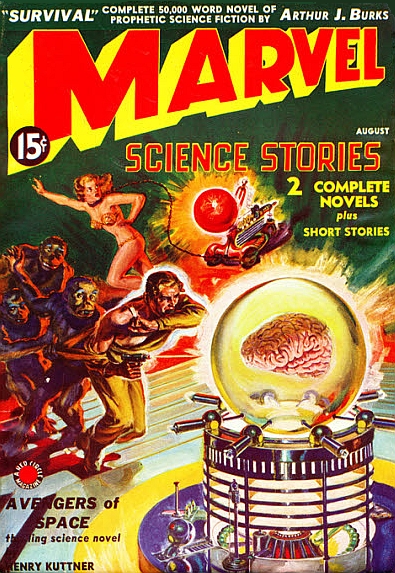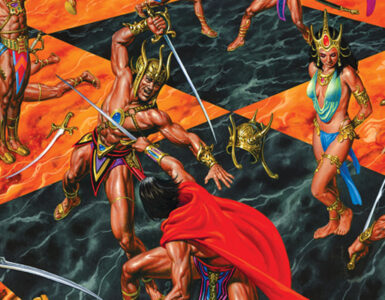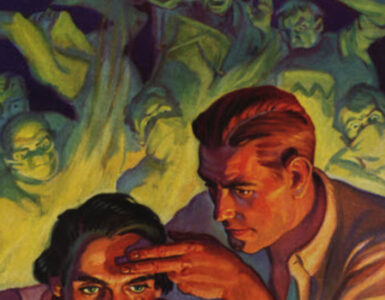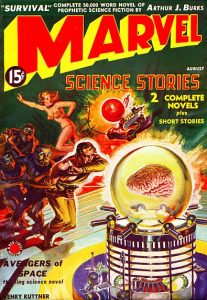 By the summer of 1938, the science-fiction genre seemed to be flourishing. Astounding was generating a good deal of excitement by helping readers to “. . . experience the new worlds that science might offer.” Thrilling Wonder Stories was nearing a peak, publishing action-adventure stories for kids. Ray Palmer was rapidly turning Amazing Stories around following years of struggle.
By the summer of 1938, the science-fiction genre seemed to be flourishing. Astounding was generating a good deal of excitement by helping readers to “. . . experience the new worlds that science might offer.” Thrilling Wonder Stories was nearing a peak, publishing action-adventure stories for kids. Ray Palmer was rapidly turning Amazing Stories around following years of struggle.
Martin Goodman, who would later be the publisher of Marvel Comics, debuted Marvel Science Stories in July. Very adept at spotting trends, Goodman would, “Let someone else risk their money experimenting with different types and genres of magazines . . . Once a winner emerged, Goodman would jump in with a knockoff. Or two. Or twelve . . . .”
Noticing the growing success of the science-fiction pulps, Goodman decided to launch his own. He acquired cover art from illustrator Norman Saunders and stories by journeymen such as Arthur J. Burks, Stanton A. Coblentz, and Henry Kuttner. Later issues would feature fiction by Eando Binder, David H. Keller, Harl Vincent, Jack Williamson, and others, and covers by Frank R. Paul and Wesso.
Not content with just one science-fiction pulp, Goodman released a second in early 1939—Dynamic Science Stories. Again using covers by Paul and Saunders, Dynamic published stories by Nelson Bond, L. Sprague de Camp, Manly Wade Wellman, Robert Moore Williams, and others. A third Goodman science-fiction title, Uncanny Stories, appeared in 1941.
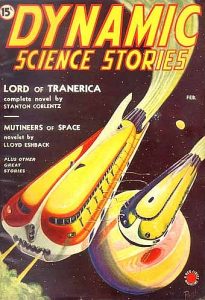 For Goodman, “. . . success meant . . . jumping on a successful trend and pumping multiple similar titles . . . through the pipeline as fast as possible in order to rake in as much profit as possible . . . . If any one foundered below a certain profit threshold, it was scuttled without so much as a backward glance.” Thus, Uncanny Stories lasted but a single issue while two numbers of Dynamic Science Stories found their way to the racks. Marvel Science Stories ran for five issues before being added to Goodman’s Red Circle weird-menace line as Marvel Tales. After two shudder pulp issues, Goodman converted it back into a science-fiction magazine entitled Marvel Stories for two more issues, the last dated April 1941. He tried another Marvel pulp during the science-fiction boom of the early fifties, but only six issues appeared.
For Goodman, “. . . success meant . . . jumping on a successful trend and pumping multiple similar titles . . . through the pipeline as fast as possible in order to rake in as much profit as possible . . . . If any one foundered below a certain profit threshold, it was scuttled without so much as a backward glance.” Thus, Uncanny Stories lasted but a single issue while two numbers of Dynamic Science Stories found their way to the racks. Marvel Science Stories ran for five issues before being added to Goodman’s Red Circle weird-menace line as Marvel Tales. After two shudder pulp issues, Goodman converted it back into a science-fiction magazine entitled Marvel Stories for two more issues, the last dated April 1941. He tried another Marvel pulp during the science-fiction boom of the early fifties, but only six issues appeared.
To learn more about the image used in this post, click on the illustrations. Click here for references consulted for this article.

